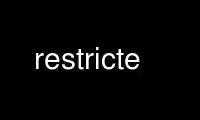
This is the command restricte that can be run in the OnWorks free hosting provider using one of our multiple free online workstations such as Ubuntu Online, Fedora Online, Windows online emulator or MAC OS online emulator
PROGRAM:
NAME
restrict - Report restriction enzyme cleavage sites in a nucleotide sequence
SYNOPSIS
restrict -sequence seqall -datafile datafile -mfile datafile -sitelen integer
-enzymes string -min integer -max integer -solofragment boolean -single boolean
-blunt boolean -sticky boolean -ambiguity boolean -plasmid boolean
-methylation boolean -commercial boolean -limit boolean -alphabetic boolean
-fragments boolean -name boolean -outfile report
restrict -help
DESCRIPTION
restrict is a command line program from EMBOSS (“the European Molecular Biology Open
Software Suite”). It is part of the "Nucleic:Restriction" command group(s).
OPTIONS
Input section
-sequence seqall
-datafile datafile
-mfile datafile
Default value: Emethylsites.dat
Required section
-sitelen integer
This sets the minimum length of the restriction enzyme recognition site. Any enzymes
with sites shorter than this will be ignored. Default value: 4
-enzymes string
The name 'all' reads in all enzyme names from the REBASE database. You can specify
enzymes by giving their names with commas between then, such as:
'HincII,hinfI,ppiI,hindiii'. The case of the names is not important. You can specify a
file of enzyme names to read in by giving the name of the file holding the enzyme
names with a '@' character in front of it, for example, '@enz.list'. Blank lines and
lines starting with a hash character or '!' are ignored and all other lines are
concatenated together with a comma character ',' and then treated as the list of
enzymes to search for. An example of a file of enzyme names is: ! my enzymes HincII,
ppiII ! other enzymes hindiii HinfI PpiI Default value: all
Advanced section
-min integer
This sets the minimum number of cuts for any restriction enzyme that will be
considered. Any enzymes that cut fewer times than this will be ignored. Default value:
1
-max integer
This sets the maximum number of cuts for any restriction enzyme that will be
considered. Any enzymes that cut more times than this will be ignored. Default value:
2000000000
-solofragment boolean
This gives the fragment lengths of the forward sense strand produced by complete
restriction by each restriction enzyme on its own. Results are added to the tail
section of the report. Default value: N
-single boolean
If this is set then this forces the values of the mincuts and maxcuts qualifiers to
both be 1. Any other value you may have set them to will be ignored. Default value: N
-blunt boolean
This allows those enzymes which cut at the same position on the forward and reverse
strands to be considered. Default value: Y
-sticky boolean
This allows those enzymes which cut at different positions on the forward and reverse
strands, leaving an overhang, to be considered. Default value: Y
-ambiguity boolean
This allows those enzymes which have one or more 'N' ambiguity codes in their pattern
to be considered Default value: Y
-plasmid boolean
If this is set then this allows searches for restriction enzyme recognition site and
cut positions that span the end of the sequence to be considered. Default value: N
-methylation boolean
If this is set then RE recognition sites will not match methylated bases. Default
value: N
-commercial boolean
If this is set, then only those enzymes with a commercial supplier will be searched
for. This qualifier is ignored if you have specified an explicit list of enzymes to
search for, rather than searching through 'all' the enzymes in the REBASE database. It
is assumed that, if you are asking for an explicit enzyme, then you probably know
where to get it from and so all enzymes names that you have asked to be searched for,
and which cut, will be reported whether or not they have a commercial supplier.
Default value: Y
Output section
-limit boolean
This limits the reporting of enzymes to just one enzyme from each group of
isoschizomers. The enzyme chosen to represent an isoschizomer group is the prototype
indicated in the data file 'embossre.equ', which is created by the program
'rebaseextract'. If you prefer different prototypes to be used, make a copy of
embossre.equ in your home directory and edit it. If this value is set to be false then
all of the input enzymes will be reported. You might like to set this to false if you
are supplying an explicit set of enzymes rather than searching 'all' of them. Default
value: Y
-alphabetic boolean
Default value: N
-fragments boolean
This gives the fragment lengths of the forward sense strand produced by complete
restriction using all of the input enzymes together. Results are added to the tail
section of the report. Default value: N
-name boolean
Default value: N
-outfile report
Use restricte online using onworks.net services
